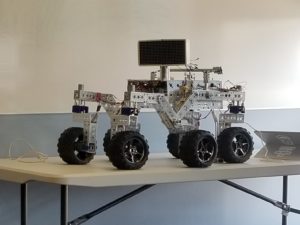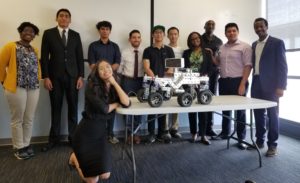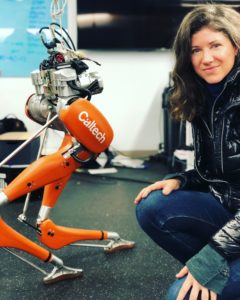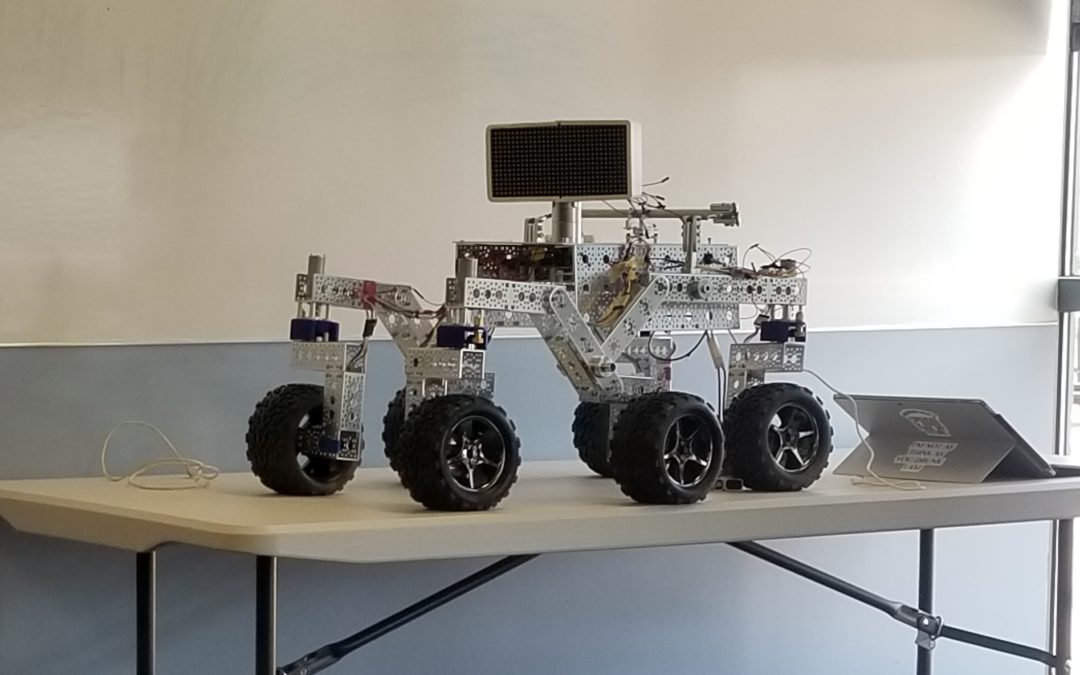By Jade Kim, Student Success Specialist
The Base 11 Academic Year Internships at UCI wrapped up in May and in June at Caltech — and the results were impressive. With a total cohort of 28 students and a 100% retention rate, this was one of Base 11’s most successful years yet. Read on to learn more about what each intern group accomplished:
UCI Autonomous Systems Engineering Academy
Students met monthly at the University of California, Irvine campus to learn lucrative skills such as how to program a Raspberry Pi, prototype using Arduino, and use computer-aided design software for 3D printing to develop their own project. Students also got to tour state-of-the-art fabrication labs used by UCI students, meet transfer students in engineering, and receive advice and guidance from admissions counselors about how to successfully transfer to a UC.

The completed Mars Rover the UCI interns built and programmed.
This year, the UCI interns got to work on The Rover Project, which is an open-source, scaled-down version of the 6-wheel rover design that JPL uses to explore the surface of Mars. The Open Source Rover is designed almost entirely out of consumer, off-the-shelf (COTS) parts. This project enabled students to gain experience in mechanical engineering, software, electronics, and robotics.
One of the students participating was Santa Monica College’s Elizabeth Juette. “I have gained so many skills! This opportunity has given me so much more than I had originally expected,” she said. “Beyond the technical skills I have learned, working with a team on a project of this scale is immensely satisfying and reaffirms my interest in pursuing my career goals. It has been an invaluable experience.”

The UCI ASEA cohort standing proudly around their Mars Rover during their final presentations.
Building a Mars rover was certainly no easy task, but the Base 11 UCI interns worked together to make it happen, pushing the boundaries of what community college students can accomplish. And this was not lost on those around them. As Compton Community College’s Fernando Bello states, “My family thinks I’m some sort of genius, Tony Stark-type of person now.”
Caltech Aerospace Mentorship Program

Caltech intern Elisa Shebaro posing with CASSIE, the bipedal semiautonomous robot.
During the Caltech AMP internship, students were able to sample the extensive resources available at one of the world’s most prestigious research institutions, while being mentored by graduate students in aerospace. Interns attended brief lectures on fundamental scientific theories and then worked in teams on projects that demonstrate basic yet elegant physics concepts essential to continued study in aerospace research. The program culminates in a final presentation of a project in an area of study that the student chooses.
This year, the students broke into teams of two to design and create their final projects. Some of the concepts that were explored included:
- Dynamics of Vortex Rings using a mechanism made from a disposal bin
- Buoyancy and Stability of Boats using a ship made from styrofoam
- A demonstration of Lenz’s Law
- LECtenna, illustrating wireless power
- The Brazil Nut Effect
Being able to explore the fundamentals of aerospace enabled each intern to learn more about where their personal passion for the field lies. As Santa Monica College’s Yeo Kim Hwang states, “This internship gave me the resources, connections, and inspiration to become a Ph.D. at an institute like Caltech. The inspiration provided through these sessions are great and should not be underestimated! It continually gives me the reminder as to what I am working towards. It also helps me to learn about the work of engineers.”
USC Liquid Propulsion Lab
In the USC Liquid Propulsion Lab internship, students who are interested in the future of rocket propulsion and space travel worked under the guidance of Ph.D. candidates to conduct research in the state-of-the-art Liquid Propulsion Lab, exploring technologies commonly used by companies like SpaceX and Virgin Galactic. The work done by this lab spans multiple disciplines and presents many opportunities for interested students to gain design and manufacturing experience.
Each intern was assigned a specific task for either the LPL’s Hydra Static Fire Test Stand or LPL’s Water Flow Test Stand. In addition to their specific assignments, students also learned Orbital Mechanics, Feed System Component Selection, and Electronics Design.
According to Compton College’s Tania Ramirez, “I have gained valuable insight into the aerospace industry over the past year. This internship has definitely increased my interest in pursuing a career in aviation.”
For more information on Base 11 programs, click here.

